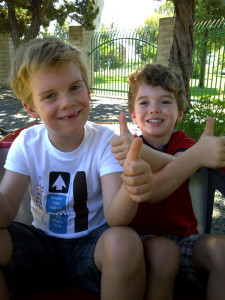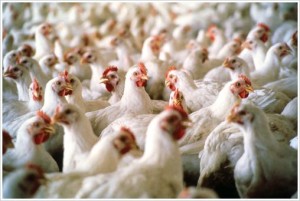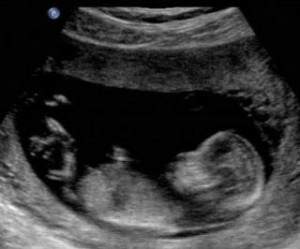One of our very own Supergays, generic website writer and poet Cheryl Dumesnil contributed this article to Out & Around. We love her as our California correspondent writing about the crossroads of parenthood, cialis 40mg remedy lesbians and suburbia.
On Chicken Butts and Sperm Donors
As I race around the kitchen, packing lunches for my kids, K-the-five-year-old and B-the-seven-year-old sit at the breakfast table, scarfing oatmeal and discussing chicken reproduction.
K: “Did you know that chicks grow in eggs only if there’s a boy chicken and a girl chicken?”
B: “Yeah, but if there’s no boy chicken then you just get the kind of eggs that you eat.”
K: “Yeah, but how does the boy chicken put the chick in the egg?”
B: Pauses. “I don’t know.” Appeals to me: “Mom?”
I know the answer to this question: the hen and rooster rub their butts together. Well, the technical description includes words like “cloaca” and “vent.” Translated into kid terms, though, it’s all about the butts.
If I tell my dudes about the butts, I will 1) incite squeals of laughter, 2) load them up with some awesome reproductive 411 to share with their friends, and 3) earn some serious street cred as a kick-ass potty talker.
As tempting as this chance to up my cool factor might be, however, I decide to swing the conversation a different way. You see, Mom has an agenda.
Recently my wife Tracie and I realized something: we know that our oldest son could recite the facts about his conception when he was a toddler, but we’re not really sure what our youngest son understands about his origins. We’re not certain if we’ve made a parenting gaff (we forgot to tell him), or if we are experiencing a memory lapse (we forgot that we told him), but either way, we need to fix it.
At some point, we figure, some playground know-it-all is going to spew the dreaded “you can’t have two moms; it takes a man and a woman to make a baby” at our kids, and we want them to be prepared to respond. But rather than staging a formal talk with little guy, we’ve decided to wait for one of those “teachable moments” to arrive.
Thank you, chicken butts, for laying this golden opportunity.
I abandon the lunchboxes and pull a chair up to the breakfast table: “Well, you know how it takes two ingredients to make a person baby?” Both boys nod. Good. “So, you know how one ingredient comes from a woman’s body, and that’s called the egg, and one ingredient comes from a man’s body, and that’s called the sperm?” Two more nods. Cool. “Same with chickens.”
A wrinkle of confusion knits little guy’s brow. I proceed. “So, do you remember that story about how mama and I wanted to make you guys, but we were missing the man ingredient, so we found a man called a donor who gave us the ingredient?”
“Yeah . . .” K nods, but there’s a question mark floating at the end of that word. I wait. “But where did you find him? At like a store or something?”
“Kind of like a store,” I say. “It’s called a sperm bank.”
“And maybe someday we could go there and meet him?” K asks. Is he remembering that we chose an “identity release” donor, willing to meet the boys after they turn eighteen, or is he asking to meet the guy right now?
“Well, he’s not actually at the sperm bank. But when you’re eighteen, if you want to meet him, the people at the sperm bank will help us find him for you.”
No matter what our kids’ origins, all parents walk into delicate territory when their children ask “Where did I come from?” Answering this question isn’t any more awkward for queer folks than it is for straight couples. But while hetero parents have whole books dedicated to advising them in these conversations, we are exploring relatively new psychological ground here. We enter these conversations armed only with our best intentions and a desire to tell the truth, in terms that our kids can understand.
While I often wish I had a list of FAQs and corresponding, psychologist-approved responses to guide me in these discussions, after seven years of winging it, I’m beginning to trust my instincts.
But my window of opportunity is closing on this morning’s chat. In a classic, done-with-this-conversation move, B changes topics: “So, Mom, when I get my iPod, I want you to put all the songs I like on it, okay?”
“Sounds good, kiddo,” I nod.
Just when I’m about to pat myself on the back for navigating donor territory pretty darned well, I look over at K, whose face has transmuted into one of those big-eye Margaret Keane paintings from the 1960s. Uh oh. “What’s up, buddy?” I venture.
And then he says it, in a voice two octaves above normal: “Mommy, did the boy who helped make me not want me?”
Ugh.
The question eviscerates me. As I scramble to stuff my guts back into my body, I stare deep into those saucer eyes and say, “No way buddy. I can’t think of a single person on this entire Earth who wouldn’t want you.”
My response is emotional, knee-jerk, subpar. Not to mention, it’s a lie. I know plenty of folks who don’t want kiddos, not even fabulous ones like Mr. K here. In truth, I don’t know how our donor feels about kids. I just know that he wanted to help people like us create families. Aha! That’s my entry point. “The donor wanted to help people like Mama and me who couldn’t make babies on our own, and we are so lucky that he did, because now we have you!”
I study K’s face to see how this goes over. He gives me a beatific smile, closes his eyes, and nods. Read: Yes, Mom, you really are lucky. Then he opens his eyes and turns to his brother, “When you get your iPod, I get to listen to it too, right?”
Game over.
Except it’s not over for me. It’s never over for the parent. Kids move on. Parents second guess, worry, overthink. So while the kiddos hammer out the details of their iPod agreement, I search the house for Tracie, whom I find in the bathtub, and I unload the entire conversation: chicken inquiry, instructional detour, zinger question, improvised answer.
“Sounds like you did a good job, babe,” she concludes.
“Guess we’ll see,” I shrug.
“So if it comes up again,” she says, “we’ll just focus on how the donor wanted to help us make the babies we wanted.”
“No way, man,” I shake my head. “Next time I’m sticking with chicken butts.”





6 Responses
Funny story 🙂
I too have no interest in jnnoiig the DSR, but if my daughter decides she wants to, I will not stop her. One of the reasons I decided on having another child was for her to have a full sibling. In the end it might be the only family she needs, but again it might not be. Even with open ID the donor has the right to change his mind about disclosing his identity. However, if my daughter is anything like me, she may not take that as a final answer. In the end I fully intend to let her know that in spite of my best efforts to give her the opportunity to know her other genetic half, that may not be the case. One thing that surprised me was the feeling of dread when I found the number of siblings she had. I knew this was likely the case, and I’m sure there are even more who have not registered, in fact given he had a 40 family max, there are potentially at least 39 other children. I don’t regret my choice, but it will be interesting to see how this all turns out. Hindsight is always 20/20, but I sure wish it wish I had a crystal ball when it comes to knowing what impact my choice will have on my daughter.
Love this:
And also? Chicken butts for sure, next time. Thank you for sharing this, Cheryl. It’s an honor to tread this delicate territory in earshot of you.
J-bird, I wouldn’t worry too much about those uedsits of the children of single mothers and bad outcomes. Most of those women are not “really” SMCs the key difference being that the majority of SMCs actively choose to parent alone, even if they conceived the child in a relationship . . . which is a different position than that of a woman who “winds up” parenting alone. As near as I can tell as the mother of a teenage DI child, from conversations with other SMC mothers of teenage and/or adult DI children, our children are, socially, like the children of intact two-parent families. They have low rates of smoking/drinking/drug use, criminality, and other negatives. They’re going to or graduated from college, they have jobs, etc. In my lay opinion, the difference is that SMC children do not, for the most part, perceive their families as “lacking” or “broken.” Their families, like two-parent families, are “intact.” As far as father-figures are concerned, I have found that thinking about “male role models” puts a better spin on things. And my daughter has had a number of positive male role models in her life, from my father (now deceased) and brother to teachers, family friends, and even the guy who used to run the local pizza parlor, who “fathered” all the kids who came in. I know that lots of women worry about the “emptiness” of the SMC life, but, again speaking personally, my daughter and I don’t experience any kind of emptiness. Our lives, in fact, are very full, with friends, family, and community. Best of luck with your thinking. I don’t in any way mean to make light of the thinking process. But 14+ years into the mothering part, I know that what seem like mountains when you’re thinking or a new parent are just molehills when you look back later.
Lovely article, Cheryl. Fun read. Good work.
The possibility that my deuthgar could be “10th in line” (or further back!) was always in my mind when I chose an ID Release donor. However that’s one of the things I can’t control. What was most important to me was that I was giving her the opportunity to at least know his name. Thanks to the timing of my SMC plans, I was able to do more than that as well. By 2007 there were a couple of banks that offered adult photos of even their ID Release donors, and I chose one of them. So when she is a little older (she is 2) I can show these to her, and she’ll know what he looks like well before she is 18. That also seems comforting to me, making it less clinical. (I can tell you the whole process got less clinical for me, the day I pulled those pics out of the FedEx envelope from Fairfax!)The other thing I have considered is that even if her donor is inundated with requests for contact when “the wave” hits (he is retired and very few vials are available I’m on the waitlist and have recieved only two, so I expect the sibs to “cluster” within 2-4 years of my deuthgar’s age), he may be more open to more meaningful contact in later years, when things die down a bit. However things turn out, I also feel I chose a truly wonderful donor for my little one. From his pictures, his survey and his audio interview, his personality radiates good character and kindness, and his responses (I think) reveal a sense of responsiblity to give any offspring some kind of understanding of who he is, when the time comes. At any rate I at least hope my deuthgar feels I did my best in choosing the man who is, whatever name I choose to use for him, her biological father.